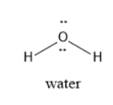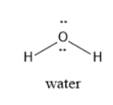
Concept explainers
(a)
Interpretation: The structural formulas of nitrogen, oxygen, carbon dioxide and water vapor needs to be drawn including the lone pair of electrons.
Concept Introduction :
To draw the structural formulas and Lewis dot structure of the molecules, count the total number of valence electrons of all the constituent atoms.
Arrange the electrons around each atom in such a way that each atom should get eight electrons around it.
Lone pair of electrons does not participate in
Due to the presence of lone pair of electrons, the molecule deviates from its regular shape and exhibits polarity.
(a)
Explanation of Solution
Nitrogen structure N2:
The total number of valence electrons in N2 is 5+5 = 10
Structure of N2:

Nitrogen is a linear molecule.
Oxygen: Total number of valence electrons in oxygen is 6+6 =12.
Arrange these electrons in such a way that each atom should be surrounded by eight electrons.

Oxygen is a linear molecule.
Water Vapor:
Valence electrons in oxygen atom are 6.
Hydrogen has one valence electron.
Total water has 6+2=8 electrons.
Arrange them in such a way that oxygen should get 8 electrons around it and hydrogen should get two electrons.

Water has bent shape.
Carbon dioxide:
Carbon has four valence electrons.
Oxygen has six valence electrons.
Total number of valence electrons = 4+ 6+6=16 electrons.
Structure of CO2:

Carbon dioxide is a linear molecule.
(b)
Interpretation: The Lewis structure of water needs to be drawn.
Concept Introduction: To draw Lewis dot structure of water, count the total number of valence electrons of all the constituent atoms.
Then, arrange the electrons around each atom in such a way that oxygen should have eight electrons and hydrogen has two electrons.
(b)
Explanation of Solution
Valence electrons in oxygen atom are 6.
Hydrogen has one valence electron.
Total water has 6+2=8 electrons.
Arrange them in such a way that oxygen should get 8 electrons around it and hydrogen should get two electrons.

(c)
Interpretation: Polar and non-polar molecules among nitrogen, oxygen, water and carbon dioxide needs to be determined.
Concept Introduction:
In Lewis dot structure the central atoms that carry lone pair of electrons are polar.
(c)
Explanation of Solution
Nitrogen is a polar molecule, since nitrogen has a lone pair.
Oxygen is a polar molecule, since oxygen has two lone pairs of electrons.
Water is a polar molecule, since oxygen has two lone pairs of electrons.
Carbon dioxide is a nonpolar molecule, since dipole moment of C-O polar bond cancels on each direction.
(d)
Interpretation: Natural occurrence of these molecules needs to be explained.
Concept Introduction:
The molecules which have strong intermolecular forces of attraction can exist as solids and then liquid and weak intermolecular forces of attraction make them exist as gases.
(d)
Explanation of Solution
Water exists as a liquid at room temperature due to strong H-bond.
Nitrogen, oxygen and carbon dioxide exist as gases under normal conditions.
Chapter U3 Solutions
Living by Chemistry
Additional Science Textbook Solutions
Microbiology: An Introduction
Physics for Scientists and Engineers: A Strategic Approach, Vol. 1 (Chs 1-21) (4th Edition)
Anatomy & Physiology (6th Edition)
College Physics: A Strategic Approach (3rd Edition)
Chemistry: An Introduction to General, Organic, and Biological Chemistry (13th Edition)
Organic Chemistry (8th Edition)
- Please draw, not just describe!arrow_forwardcan you draw each step on a piece of a paper please this is very confusing to mearrow_forward> Can the molecule on the right-hand side of this organic reaction be made in good yield from no more than two reactants, in one step, by moderately heating the reactants? esc ? A O O •If your answer is yes, then draw the reactant or reactants in the drawing area below. You can draw the reactants in any arrangement you like. • If your answer is no, check the box under the drawing area instead. olo 18 Ar Explanation Check BB Click and drag to start drawing a structure. 2025 McGraw Hill LLC. All Rights Reserved. Terms of Use | Privacy Center Accessibilityarrow_forward
- Name the structurearrow_forward> For each pair of substrates below, choose the one that will react faster in a substitution reaction, assuming that: 1. the rate of substitution doesn't depend on nucleophile concentration and 2. the products are a roughly 50/50 mixture of enantiomers. Substrate A Substrate B Faster Rate X CI (Choose one) (Choose one) CI Br Explanation Check Br (Choose one) C 2025 McGraw Hill LLC. All Rights Reserved. Terms of Use | Privacy A F10arrow_forwardHow to draw this mechanism for the foloowing reaction in the foto. thank youarrow_forward
- Predict the major products of the following organic reaction: Some important notes: CN A? • Draw the major product, or products, of the reaction in the drawing area below. • If there aren't any products, because no reaction will take place, check the box below the drawing area instead. • Be sure to use wedge and dash bonds when necessary, for example to distinguish between major products that are enantiomers. No reaction. Explanation Check Click and drag to start drawing a structure. 2025 McGraw Hill LLC. All Rights Reserved. Terms of Use Privacy Centerarrow_forwardDraw the major product of the following reaction. Do not draw inorganic byproducts. H3PO4 OHarrow_forwardPredict the major products of this organic reaction: HBr (1 equiv) Δ ? Some important notes: • Draw the major product, or products, of this reaction in the drawing area below. • You can draw the products in any arrangement you like. • Pay careful attention to the reaction conditions, and only include the major products. • Be sure to use wedge and dash bonds when necessary, for example to distinguish between major products that are enantiomers. • Note that there is only 1 equivalent of HBr reactant, so you need not consider the case of multiple additions. Explanation Check X ©2025 McGraw Hill LLC. All Rights Reserved. Terms of Use | Privacyarrow_forward
- For the structure below, draw the resonance structure that is indicated by the curved arrow(s). Be sure to include formal charges. :ÖH Modify the second structure given to draw the new resonance structure. Include lone pairs and charges in your structure. Use the + and - tools to add/remove charges to an atom, and use the single bond tool to add/remove double bonds.arrow_forwardUsing the table of Reactants and Products provided in the Hints section, provide the major product (with the correct stereochemistry when applicable) for questions below by selecting the letter that corresponds to the exact chemical structures for the possible product. OH conc Hydrochloric acid 40°C Temp A/arrow_forwardUsing arrows to designate the flow of electrons, complete the reaction below and provide a detailed mechanism for the formation of the product OH conc Hydrochloric acid 40°C Temp All chemical structures should be hand drawn on a piece of paper Paragraph BI UAE +varrow_forward
 ChemistryChemistryISBN:9781305957404Author:Steven S. Zumdahl, Susan A. Zumdahl, Donald J. DeCostePublisher:Cengage Learning
ChemistryChemistryISBN:9781305957404Author:Steven S. Zumdahl, Susan A. Zumdahl, Donald J. DeCostePublisher:Cengage Learning ChemistryChemistryISBN:9781259911156Author:Raymond Chang Dr., Jason Overby ProfessorPublisher:McGraw-Hill Education
ChemistryChemistryISBN:9781259911156Author:Raymond Chang Dr., Jason Overby ProfessorPublisher:McGraw-Hill Education Principles of Instrumental AnalysisChemistryISBN:9781305577213Author:Douglas A. Skoog, F. James Holler, Stanley R. CrouchPublisher:Cengage Learning
Principles of Instrumental AnalysisChemistryISBN:9781305577213Author:Douglas A. Skoog, F. James Holler, Stanley R. CrouchPublisher:Cengage Learning Organic ChemistryChemistryISBN:9780078021558Author:Janice Gorzynski Smith Dr.Publisher:McGraw-Hill Education
Organic ChemistryChemistryISBN:9780078021558Author:Janice Gorzynski Smith Dr.Publisher:McGraw-Hill Education Chemistry: Principles and ReactionsChemistryISBN:9781305079373Author:William L. Masterton, Cecile N. HurleyPublisher:Cengage Learning
Chemistry: Principles and ReactionsChemistryISBN:9781305079373Author:William L. Masterton, Cecile N. HurleyPublisher:Cengage Learning Elementary Principles of Chemical Processes, Bind...ChemistryISBN:9781118431221Author:Richard M. Felder, Ronald W. Rousseau, Lisa G. BullardPublisher:WILEY
Elementary Principles of Chemical Processes, Bind...ChemistryISBN:9781118431221Author:Richard M. Felder, Ronald W. Rousseau, Lisa G. BullardPublisher:WILEY





